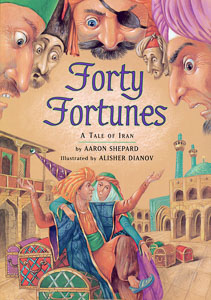Here is the author note from my picture book.—Aaron
The story of the would‑be fortuneteller is one of the most popular tales of Iran and the rest of the Islamic world, and is found in countless versions. You might enjoy looking for them in folktale collections and discovering his additional adventures.
Here are a few notes on elements of the story:
Isfahan. Isfahan was made the capital of Iran in 1598 by Shah Abbas the Great, and remained so for over a century. Under Abbas, the city became known as one of the most beautiful in the world, and it grew to be a major international center of commerce and the arts. This period is considered a Golden Age in Persian culture. (Persia is the former name of Iran.)
Divining/fortunetelling. The attempt to discover hidden knowledge by mystic means seems to have been practiced in every culture throughout history. The Persian art of divining with dice is called raml (pronounced “RAH‑mul”). The diviner throws a set of eight dice, then answers the question at hand by interpreting their pattern, often with the help of a book.
Clothes. Muslim law requires both women and men to dress “modestly” in public, keeping almost all of the body covered. The traditional covering for Iranian women is a garment called chador (pronounced “chah‑DOR”). This is a one‑piece cloak and shawl combined, most often black or dark blue, which wraps loosely around the woman’s regular clothes. Though today the women of Iran are no longer forced to wear the chador, most of them do anyway.
Public baths. Trips to the public bath, or hammam, have been an important part of traditional social life in Iran and the Middle East. The bath is a building with large, shallow pools filled with hot water—an Eastern version of the hot tub. Both men and women use the bath, but in separate rooms or at separate times.
Houses. In Iran, the flat roofs of the traditional adobe houses are designed as living spaces. Here the family sleeps on summer nights to escape the heat indoors. Stairs lead to the roof from inside, and a high wall surrounds it for privacy.
Though many versions of this tale were consulted, I based my retelling chiefly on “The Story of the Fortune-Teller,” in Persian Tales, collected and translated by D. L. R. and E. O. Lorimer, Macmillan, London, 1919. I am indebted also to the many students, teachers, and librarians who took part in my email program Works in Progress during the first half of 1995. Their comments on an early draft were invaluable in guiding my revisions.
